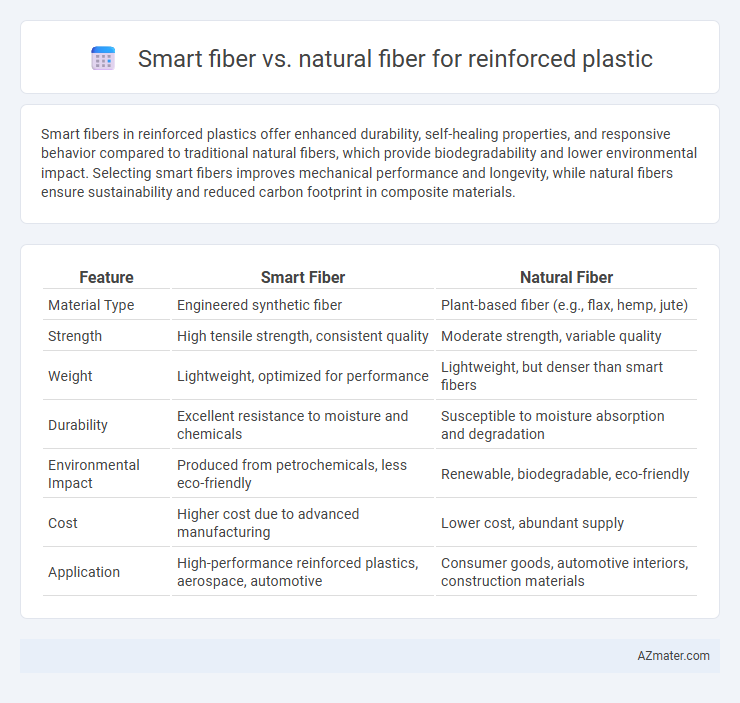Smart fibers in reinforced plastics offer enhanced durability, self-healing properties, and responsive behavior compared to traditional natural fibers, which provide biodegradability and lower environmental impact. Selecting smart fibers improves mechanical performance and longevity, while natural fibers ensure sustainability and reduced carbon footprint in composite materials.
Table of Comparison
| Feature | Smart Fiber | Natural Fiber |
|---|---|---|
| Material Type | Engineered synthetic fiber | Plant-based fiber (e.g., flax, hemp, jute) |
| Strength | High tensile strength, consistent quality | Moderate strength, variable quality |
| Weight | Lightweight, optimized for performance | Lightweight, but denser than smart fibers |
| Durability | Excellent resistance to moisture and chemicals | Susceptible to moisture absorption and degradation |
| Environmental Impact | Produced from petrochemicals, less eco-friendly | Renewable, biodegradable, eco-friendly |
| Cost | Higher cost due to advanced manufacturing | Lower cost, abundant supply |
| Application | High-performance reinforced plastics, aerospace, automotive | Consumer goods, automotive interiors, construction materials |
Introduction to Reinforced Plastics
Reinforced plastics combine polymer matrices with fibers to enhance mechanical properties like strength, stiffness, and durability. Smart fibers, incorporating materials such as carbon nanotubes and shape memory alloys, offer adaptive functions including self-sensing and damage detection, surpassing traditional natural fibers like hemp or flax in performance. The integration of smart fibers in reinforced plastics enables advanced applications in aerospace, automotive, and civil engineering through improved functionality and long-term reliability.
Overview of Fiber Reinforcement
Fiber reinforcement in reinforced plastics significantly enhances mechanical properties by distributing stress and improving durability. Smart fibers, embedded with sensors or conductive materials, enable real-time structural health monitoring and damage detection, offering advanced functionality beyond traditional reinforcement. Natural fibers, such as flax and hemp, provide sustainable alternatives with lower density and environmental impact but generally exhibit lower strength and moisture resistance compared to synthetic or smart fibers.
What are Natural Fibers in Composites?
Natural fibers in composites refer to plant-based materials such as flax, hemp, jute, and sisal used as reinforcements in reinforced plastics to enhance strength and reduce environmental impact. These fibers offer biodegradability, low density, and renewability, making them an eco-friendly alternative to synthetic fibers in composite manufacturing. Their compatibility with polymer matrices improves mechanical properties while promoting sustainability in automotive, construction, and packaging industries.
Defining Smart Fibers: Features and Types
Smart fibers in reinforced plastics refer to advanced materials engineered to respond to environmental stimuli such as temperature, moisture, or stress, enhancing the composite's performance and adaptability. These fibers include shape memory alloys, piezoelectric fibers, and carbon nanotubes, each offering unique properties like self-healing, sensing, or actuation capabilities. In contrast to natural fibers such as flax or jute, smart fibers enable multifunctional composites with improved durability, conductivity, and mechanical strength essential for high-tech applications.
Mechanical Properties: Smart Fiber vs Natural Fiber
Smart fibers in reinforced plastics exhibit superior mechanical properties such as higher tensile strength, enhanced impact resistance, and improved fatigue durability compared to natural fibers, which generally offer moderate strength and stiffness but lower endurance. The advanced composition of smart fibers allows for better stress distribution and energy absorption, resulting in composites that perform reliably under dynamic loading conditions. Natural fibers provide benefits like lightweight and environmental sustainability; however, their variability and lower mechanical consistency make them less effective in high-performance applications than smart fibers.
Sustainability and Environmental Impact
Smart fibers in reinforced plastics offer enhanced sustainability through recyclability and reduced carbon footprints compared to natural fibers, which are biodegradable but often involve intensive agricultural inputs and land use. The production of smart fibers generally consumes less water and energy, minimizing environmental impacts linked to resource depletion and pollution. Natural fibers provide renewable options but may result in soil degradation and pesticide use, whereas smart fibers enable improved lifecycle performance and material efficiency in eco-friendly composites.
Cost Comparison: Smart Fiber vs Natural Fiber
Smart fibers used in reinforced plastics, such as carbon or glass fibers, typically incur higher cost due to advanced manufacturing processes and superior mechanical properties, averaging $15 to $30 per kilogram. Natural fibers like hemp, flax, or jute offer a more cost-effective alternative, ranging from $1 to $5 per kilogram, driven by their renewable sourcing and lower processing expenses. Despite higher upfront costs, smart fibers often provide better durability and performance, influencing long-term cost efficiency in composite applications.
Applications and Industry Usage
Smart fibers in reinforced plastics offer enhanced properties such as self-sensing, shape memory, and adaptive behavior, making them ideal for aerospace, automotive, and advanced biomedical applications where performance and functionality are critical. Natural fibers, including flax, hemp, and jute, are commonly used in consumer goods, construction, and automotive interiors due to their sustainability, low cost, and lightweight characteristics. Industries increasingly adopt smart fiber composites for high-precision requirements, while natural fiber composites remain popular in eco-friendly and cost-sensitive manufacturing sectors.
Durability and Performance Analysis
Smart fibers in reinforced plastics exhibit superior durability by offering enhanced resistance to environmental stress, UV radiation, and mechanical wear compared to natural fibers. Performance analysis reveals that smart fibers provide higher tensile strength, improved impact resistance, and greater dimensional stability, making them ideal for demanding construction and automotive applications. Natural fibers, while eco-friendly and lightweight, typically demonstrate lower durability and inconsistent performance under harsh conditions, limiting their use in high-performance composite structures.
Future Trends in Fiber-Reinforced Plastics
Smart fibers, integrating sensors and responsive materials, are revolutionizing reinforced plastics by enabling real-time monitoring of structural health and adaptive performance, while natural fibers offer sustainable and lightweight alternatives with lower environmental impact. Future trends indicate a growing hybridization of smart and natural fibers in reinforced plastics to combine enhanced functionality with eco-friendly properties. Advances in nanotechnology and bio-based resins will further drive the adoption of fiber-reinforced plastics that deliver superior mechanical strength, self-healing capabilities, and reduced carbon footprint.

Infographic: Smart fiber vs Natural fiber for Reinforced plastic
 azmater.com
azmater.com